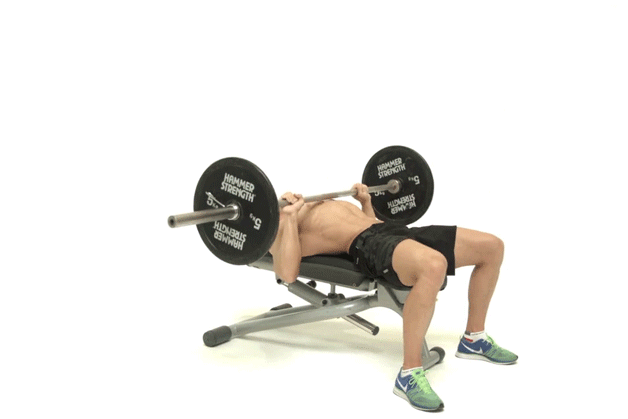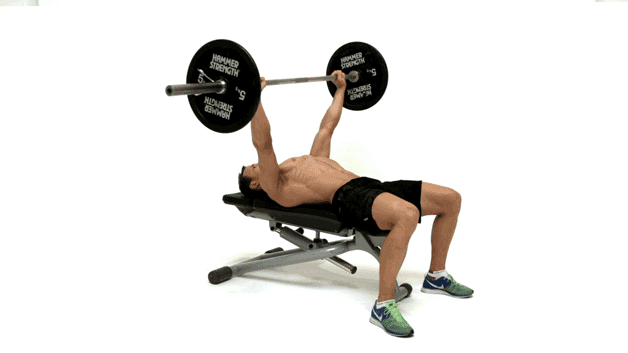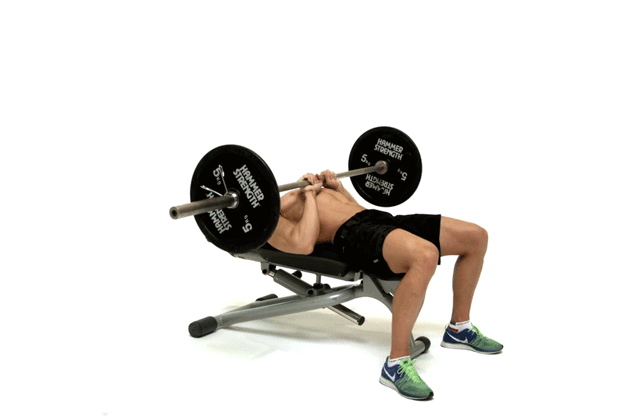Bench Press Exercises
Step 1: build up strength
The bench press is largely dependent on two muscle groups; your chest and your triceps. If you’re yet to step into the gym, there’s one exercise which will power up those muscles – the humble press-up.

- Correct form: Set up with your weight supported on your toes and hands beneath your shoulders, body straight.
- Take care to keep you core locked so a straight line forms between your head, glutes and heels.
- Lower your body until your chest is an inch from the ground then explosively drive up by fully extending your arms.
The press-up is perfect for beginners because it requires no equipment and is both simple and super effective. Five sets of 10 every other morning before work will soon put some power in your pecs.
Step 2: master the form
It’s OK to start off with a very light weight or just the bar. Good habits today will pay dividends down the road.

- How to: Lie back on a flat bench holding a barbell in the rack above you with a shoulder-width, overhand grip.
- Drive your feet into the floor to contract your quads and glutes, and clamp back your shoulder blades to shorten the weight's path of travel. This increases neural drive to your chest, delts and triceps.
- From the starting position, breathe in and lower the bar slowly until it skims the middle of your chest.
- Focus your mind on activating your chest muscles and push the bar back to the starting position explosively as you breathe out. That’s one rep.
Step 3: add more weight
Now you’re proficient in the art of bench-fu, it’s time to make your way to black belt. Begin to load your barbell with a weight you can lift for 10 or 12 reps.
PT Rogan Allport recommends a structure to help you load more weight onto the bar; for every 2 weeks, increase the weight you’re lifting by 5kg and knock off a couple of reps. You’ll be doing 8-10 reps for the next 2 weeks and 6-8 reps after that. At the end of this cycle, go back to 10-12 reps but keep the weight you were using, which should be 15kg heavier than when you started.
Step 4: variations
Now you’ve got a clear goal in mind when you lie down in the gym, it’s time to mix it up. These three bench-press variants will hit different parts of your pecs ensuring no two sessions are the same. Remember to take some weight off: if this is your first time with these variations, you'll want to lift light to nail your form.
Incline bench press

- How to: Lie back on a bench set to an incline angle and lift a barbell to shoulder height, palms facing away from you.
- Breathe out as you press up with both arms. Lock out your arms and squeeze your chest before returning slowly to the start position.
Why? You’re hitting the upper part of your pectoral that’s often neglected during the flat bench press, ensuring a stronger body and a perfectly-sculpted pec. Great news when you're toting a v-necked tee.
Wide-grip bench press

- How to: Lie back on a flat bench holding a barbell with an overhand grip, hands set wider than your shoulders. From the starting position, breathe in and lower the bar slowly.
- Push the bar back to the starting position explosively as you breathe out. Focus on pushing the bar using your chest muscles.
Why? A wider grip incorporates more muscles in the exercise, leading to a greater engagement of your pecs, shoulders and abs. Are your weak shoulders and upper-back muscles causing your bench press to wobble? Allport recommends supplementing your bench with bent-over rows and lat pull-downs.
Close-grip

- How to: Lie back on a flat bench holding a barbell with a narrow, overhand grip. From the starting position, breathe in and lower the bar slowly until it skims the middle of your chest.
- Push the bar back to the starting position explosively as you breathe out. Focus on pushing the bar using your chest muscles.
Why? Forget your chest – this tough variation shifts all the emphasis over to your tris, making this an essential arm-builder.